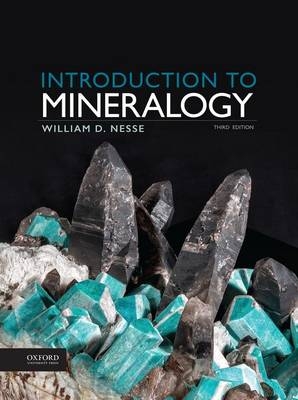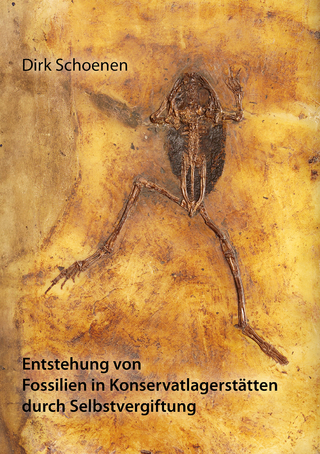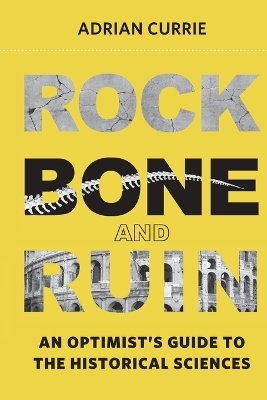
Introduction to Mineralogy
Oxford University Press Inc (Verlag)
978-0-19-061835-3 (ISBN)
occurrence of minerals.FEATURESDescribes in detail physical, optical, and X-ray powder diffraction techniques of mineral studyOutlines common
chemical analytical methodsProvides thorough descriptions of more than 100 common minerals, emphasizing the geologic contexts within which they occurIncludes tables and diagrams that help students identify minerals using both physical and optical propertiesIncorporates numerous line drawings, photographs, and photomicrographs that elucidate complex conceptsIntroduction to Mineralogy can
be packaged with Daniel Schulze's An Atlas of Minerals in Thin Section for use in your course for a nominal additional fee.
William D. Nesse is Professor Emeritus of Geology at the Department of Earth Sciences at the University of Northern Colorado.
Each chapter opens with an Introduction and ends with References Cited and Suggestions for Additional Reading.
PART ONE. CRYSTALLOGRAPHY AND CRYSTAL CHEMISTRY
Chapter 1. Introduction
Minerals
Mineraloids
Mineralogy
Mineral Nomenclature
General References on Mineralogy
Minerals and Society
--Natural Resources
--Minerals and Health
Getting Started
Box 1.1 Getting Started: Mineral Physical Properties
Chapter 2. Crystallography
Translational Symmetry: Two Dimensions
Plane Lattices
Translational Symmetry: Three Dimensions
--Space Lattices and Unit Cell
--Bravais Lattices and Crystal Systems
Point Symmetry
--Reflection
--Rotation
--Inversion
--Compound Symmetry Operations
--Symmetry Notation
The 32 Point Groups
--Steno's Law
--Measurement of Crystal Angles
--Determining Crystal System and Crystal Class
Space Groups
Box 2.1 Quasicrystals
Crystal Faces
--Laws of Haüy and Bravais
--Miller Indices
--Indices and Crystal Axes in the Hexagonal Crystal System
--Determining Miller Index
-- Crystallographic Planes
--Assigning Miller Indexes by Inspection
Crystallographic Directions
Zones
Crystal Forms
--Isometric Forms
--Non-isometric Forms
--Combining Crystal Forms
--Enantiomorphous Forms and Crystals
--Positive and Negative Forms
Forms in the Six Crystal Systems
--Triclinic Crystal System
--Monoclinic Crystal System
--Orthorhombic Crystal System
--Tetragonal Crystal System
--Hexagonal Crystal System
--Isometric Crystal System
Crystal Habit
Chapter 3. Crystal Chemistry
The Nature of Chemical Elements
--Nucleus
--Electrons
--Formation of Ions
Abundance of the Elements
Chemical Bonding
--Valence-Related Bonding
--Relation among Valence-Dependent Bondings
Conductors, Insulators, and Semiconductors
--Bonds Involving Asymmetric Charge Distribution
Size of Atoms and Ions
--Oxidation State
--Coordination
Chapter 4. Crystal Structure
Illustrating Mineral Structures
Controls of Crystal Structure
--Structure Controls with Metallic Bonding
--Structure Controls with Covalent Bonding
--Structure Controls with Ionic Bonding
--Application of Pauling's Rules
Structure Controls with Molecular Crystals
Isostructural Minerals
Polymorphism
--Reconstructive Polymorphism
--Displacive Polymorphism
--Order-Disorder Polymorphism
--Polytypism
Mineral Classification
Compositional Variation in Minerals
--Substitutional Solid Solution
--Omission Substitution Solution
--Intersitial Substitution
Mineral Formulas
Graphical Representation
--Binary diagrams
--Ternary diagrams
Chapter 5. Mineral Growth
--Mineral Stability
--Stability
--Gibbs Free Energy
--Mineral Reactions
Phase Diagrams
--Single-Component Systems
--Binary Systems
Mineral Nucleation
--Homogeneous Nucleation
--Heterogeneous Nucleation
Crystal Growth
--Rate of Growth
--Zoned Crystals
Structural Defects
--Point Defects
--Line Defects
--Planar Defects
Twinning
--Growth Twinning
--Transformation Twinning
--Deformation Twinning
Post-crystallization Processes
--Ordering
--Twinning
--Recrystallization
--Exsolution
--Pseudomorphism
--Radioactivity and Minerals
Mineral Evolution
Biomineralization
--Biologically Induced Mineralization
--Biologically Controlled Mineralization
--Applications
PART II: Mineral Properties, Study, and Identification
Chapter 6. Physical Properties of Minerals
Mass Dependent Properties
--Density
--Specific Gravity
Properties Related to Mechanical Cohesion
--Hardness
--Tenacity
--Cleavage
--Fracture
--Parting
Color and Luster
--Light
--Perception of Color
--Mineral Luster
--Mineral Color
--Color from Mechanical Causes
--Consistency of Mineral Color
--Streak
--Luminescence
Magnetism
--Diamagnetism
--Paramagnetism
--Ferromagnetism
--Ferrimagnetism
Electrical Properties
--Electrical Conductivity
--Piezoelectricity
--Pyroelectricity
Miscellaneous Properties
Chapter 7. Optical Mineralogy
Introduction
Light
--Light Waves
--Polarized Light
Interaction of Light and Matter
--Optically Isotropic vs. Anisotropic Materials
--Reflection and Refraction
--Dispersion
Petrographic Microscope
--Illuminator
--Substage Assembly
--Microscope Stage
--Objective Lenses
--Upper Polarizer
--Bertrand Lens
--Oculars
--Focusing Mechanism
--Accessories
--Direction Conventions
Isotropic Materials
Anisotropic Minerals
--Interference Phenomena
--Use of the Interference Color Chart
--Extinction
--Function of Accessory Plates
Optical Indicatrix
--Isotropic Indicatrix
--Uniaxial Indicatrix
--Biaxial Indicatrix
Mineral Color & Pleochroism
--Isotropic Minerals
--Uniaxial Minerals
--Biaxial Minerals
Extinction Angle and Sign of Elongation
--Extinction Angle
--Sign of Elongation
--Categories of Extinction
--Extinction in Uniaxial Minerals
--Extinction in Biaxial Minerals
Interference Figures
--Uniaxial Interference Figures
--Biaxial Interference Figure
Refractometry: Measurement of Index of Refraction
--Immersion Method
--Refractometry in Thin Section
--Isotropic Minerals
--Uniaxial Minerals
--Biaxial Minerals
Reflected-Light Optics
--Observation in Plane-Polarized Light
--Observations with Crossed Polarizers
--Internal Reflections
Tactics for Mineral Identification
--Thin Section Identification
--Grain Mount Identification
--Polished Section Identification
Chapter 8. Introduction to X-ray Crystallography
X-rays
--X-ray Generation
--X-ray Detection
X-ray Diffraction
Powder Method
--Sample Preparation
--Instrumental Output
--Data Reduction
--Powder Diffraction File
--Bragg Reflection Indices
--Mineral Identification
--Mixed Samples
--Estimation of Relative Mineral Abundance
--Estimation of Composition
Determining Unit Cell Parameters
Chapter 9. Chemical Analysis of Minerals
Analytical Methods
--Wet Chemical
--Electron Probe Microanalysis
--Scanning Electron Microscopy
--X-ray Fluorescence
--Mass Spectrometry
--Conventions in Reporting Chemical Analyses
Conversion of Chemical Analyses to Structural Formulas
Chapter 10. Strategies for Study
Presentation of Mineral Data
Mineral Identification Tactics
--Hand-Sample Identification
--Thin Section Identification
--Grain Mount Identification
--Polished Section Identification
--Electron Microprobe
--Scanning Electron Microscope (SEM)
--X-ray Diffraction
Mineral Separation
Mineral Association
Problems in Paradise
Section III: Mineral Descriptions
Chapter 11. Silicates
Silicate Structure and Classification
Silicate Chemical Formula
Mafic vs. Felsic
Igneous Rocks
--Magmatic Processes
--Igneous Environments
Terrigenous Sedimentary Rocks
--Sedimentary Processes
--Sedimentary Environments
Metamorphic Rocks
--Metamorphic Variables
--Metamorphic Processes
--Metamorphic Grade, Facies, Mineral Zone Boundaries and Isograds
--Major Compositional Groups of Metamorphic Rocks
--Metamorphic Environments
Chapter 12. Framework Silicates
Silica Group
--Quartz
Box 12.1 Micro- and Non-Crystalline Silica
--Tridymite
--Cristobalite
--Opal
Feldspar Group
--Composition
--Structure
--Al/Si Order/-Disorder
--Exsolution in the Feldspars
--Other Feldspar Intergrowths
--Twinning
--Plagioclase
Alkali Feldspar
--Distinguishing Features in Hand Sample
--Microcline
--Orthoclars
--Sanidine
--Adularia
--Anorthoclase
Feldspathoids
--Nepheline
--Leucite
--Sodalite
Zeolite Group
Other Framework Silicates
--Scapolite
Chapter 13. Sheet Silicates
Structure and Classification
--1:1 Layer Silicates
--2:1 Layer Silicates
--Polytypism
TO Structures (1:1)
--Serpentine (Antigorite, Chrysotile, Lizardite)
--Kaolinite
TOT Structures (2:1)
--Talc
--Pyrophyllite
TOT + c Structures: Mica Minerals (2:1)
--Muscovite
--Biotite
--Lepidolite
--Glauconite
TOT + c Structures: Brittle Micas (2:1)
--Margarite
--Clintonite
TOT + O Structure
--Chlorite
Clay Minerals
--Structure and Classification
--Geology of Clay
--Identification
--Uses
--Clay in the Environment
Other Sheet Silicates
--Stilpnomelane
--Prehnite
--Apophyllite
--Chrysocolla
Chapter 14. Chain Silicates
Pyroxene Group
--Structure and Classification
--Geology of Pyroxenes
--Orthopyroxene
--Pigeonite
--Calcic Clinopyroxene
--Aegirine, Aegirine-Augite
--Jadeite
--Omphacite
--Spodumene
Pyroxenoid Group
--Introduction
--Wollastonite
--Rhodonite
--Pectolite
Amphibole Group
--Structure and Classification
--Geology of Amphiboles
--Orthoamphibole
--Cummingtonite-Grunerite
--Tremolite-Ferro-actinolite
--Hornblende
--Glaucophane-Riebeckite
--Other Amphiboles
Chapter 15. Disilicates and Ring Silicates
Disilicates
--Structure and Classification
--Zoisite
--Clinozoisite-Epidote
--Allanite
--Lawsonite
--Pumpellyite
Ring Silicates
--Structure & Classification
--Beryl
--Cordierite
--Tourmaline
Chapter 16. Orthosilicates
--Olivine Group
--Garnet Group
--Zircon
Aluminum Silicates
--Andalusite
--Sillimanite
--Kyanite
--Staurolite
--Chloritoid
--Titanite
--Topaz
Chapter 17. Carbonates, Sulfates, Phosphates, Borates, Tungstates, and Molybdates
Structure and Classification
Carbonates
Rhombohedral Carbonates (Calcite and Dolomite Groups)
--Calcite
Box 17.1 Limestone and Dolostone
--Magnesite
--Siderite
--Rhodochrosite
--Dolomite-Ankerite
Aragonite Group
--Aragonite
--Witherite
--Strontianite
OH-Bearing Carbonates
--Malachite
--Azurite
Box 17.2 Evaporites
Sulfates
--Gypsum
--Anhydrite
--Barite
Phosphates
--Apatite
--Monazite
--Xenotime
--Tourquoise
Tungstates and Molybdates
Borates
Chapter 18. Oxides, Hydroxides, and Halides
Oxides
X2O Group
--Cuprite
--Ice
Box 18.1 Paleoclimate
XO Group
XY2O4 Minerals
--Spinel Group
--Magnetite
Box 18.2 Sedimentary Iron Formations
--Chromite
--Spinel Series
--Chrysoberyl
X2O3 Group
--Hematite
--Corundum
--Ilmenite
XO2 Group
--Rutile
--Cassiterite
--Uraninite
Hydroxides
--Brucite
--Iron Hydroxide Minerals
--Aluminum Hydroxide Minerals
--Manganese Oxide and Hydroxide Minerals
Halides
--Halite
--Sylvite
--Fluorite
Chapter 19. Sulfides and Related Minerals
Crystal Chemistry and Classification
Sulfide Paragenesis
--Hydrothermal Deposits
--Supergene Processes
Sulfide Minerals
--Sphalerite
--Galena
--Pyrrhotite
--Chalcopyrite
--Cinnabar
--Pyrite
--Marcasite
--Molybdenite
--Bornite
--Chalcocite
--Covellite
Sulfarsenides
--Arsenopyrite
Arsenides
Tellurides
Chapter 20. Native Elements
Metals
--Gold
--Silver
--Copper
Semimetals
Nonmetals
--Sulfur
--Graphite
Box 20.1 Graphitic Carbon
--Diamond
APPENDICES
Appendix A. Effective Ionic Radii of the Elements
Appendix B. Determinative Tables
Table B.1. Non-Metallic Minerals with White, Gray, or Other Pale-Colored Streak
Table B.2. Non-Metallic Minerals with Distinctly Colored Streak
Table B.3. Minerals with Metallic and Submetallic Luster
Table B.4. Specific Gravity
Table B.5. Minerals That May Fluoresce
Table B.6. Selected Minerals That Are Ferromagnetic and Ferrimagnetic
Table B.7. Minerals That Effervesce in Dilute HCl
Table B.8. Color of Minerals in Thin Section and Grain Mount
Table B9. Indices of Refraction of Isotropic Minerals
Table B.10. Indices of Refraction of Uniaxial Minerals
Table B.11. Indices of Refraction of Biaxial Negative Minerals in Order of Increasing n6
Table B.12. Indices of Refraction of Biaxial Positive Minerals Arranged in Order of Increasing n6
Table B.13. Minerals That Produce Pleochroic Halos in Surrounding Minerals
Table B.14. Colors Exhibited by Opaque Minerals That Display Internal Reflections with Reflected Light
Appendix C. Mineral Associations
Table C1. Mineralogy of Common Igneous Rocks
Table C2. Mineralogy of Sedimentary Rocks
Table C3. Mineralogy of Common Metamorphic Rocks
Table C4. Mineralogy of Hydrothermal Sulfide Deposits
Mineral Index
Subject Index
| Erscheinungsdatum | 07.01.2017 |
|---|---|
| Zusatzinfo | Illustrations |
| Verlagsort | New York |
| Sprache | englisch |
| Gewicht | 1617 g |
| Themenwelt | Naturwissenschaften ► Geowissenschaften ► Mineralogie / Paläontologie |
| ISBN-10 | 0-19-061835-3 / 0190618353 |
| ISBN-13 | 978-0-19-061835-3 / 9780190618353 |
| Zustand | Neuware |
| Haben Sie eine Frage zum Produkt? |
aus dem Bereich


